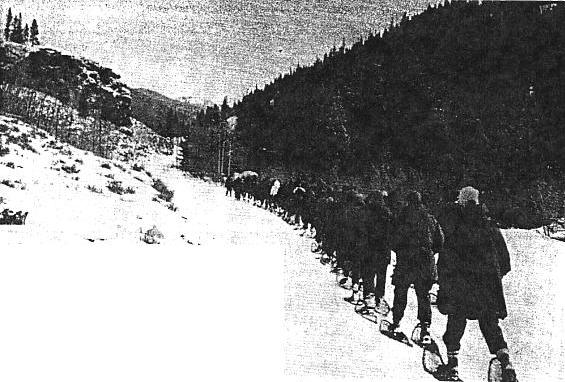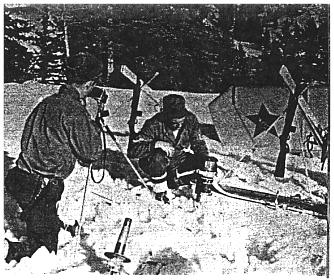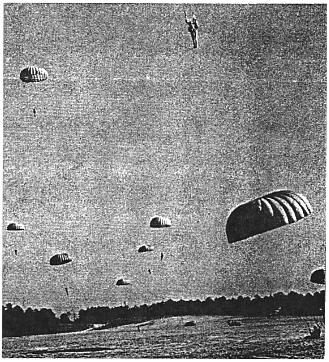|
The Aircraft Flash Vol I, NO. 7, April, 1953 Intelligence – A New Role for the ground Observer Corps
The latest addition to the air defense team - the 4602nd Air Intelligence Service Squadron - creates another important job for ground observers. Ground observers have found another niche in the Nation's air defense system. Already firmly established as one of the most important links in America's aircraft detection net, the Ground Observer Corps is ready to join forces with still another air defense function - Intelligence. This new job for skywatchers came about as a result of the formation of one of the Air Force's youngest and most unique organizations, one which you'll be hearing more about as it grows out of its swaddling clothes. It is known formally as the 4602nd Air Intelligence Service Squadron, or AISS for short. The mission of AISS, in brief, is to gather intelligence information from enemy airmen and aircraft which are downed while engaged in an attack on this country. In order to carry out that mission, it is obvious that AISS must first of all have accurate, timely knowledge of when and where these enemy aircraft go down or parachutists descend. This is where the Ground Observer Corps comes in. Members of the GOC are in a natural position to supply this information. As "the eyes and the ears of the Air Force," thousands of them are watching the sky every moment, day and night, week in and week out, throughout the entire Skywatch area. The information which AISS requires cannot be supplied by radar. Even the most modern electronic devices could not reveal whether that blip on the scope is a plane going down in flames, or whether men are parachuting out of it. But ground observers can. Of course, the GOC is not the only source of information for AISS. All civilians, particularly farmers and ranchers in isolated areas, are being encouraged to report plane crashes or parachutists to the nearest state police station or sheriff's office. GOC members should report such observations directly to their filter center via an "Aircraft Flash" message. The report should be as detailed and exact as possible. In telling of the crash of a plane, for instance, the observer should, if at all possible, give its type, distance and direct from the post, the time of the crash, the number of parachutists seen dropping from it before it hits the ground, the condition of the wrecked plane and any other discernible information. The observer should be sure to keep his phone connection with the filter center until released, in case there are questions. Under no circumstances should be make any attempt capture the survivors or approach the wreckage. Such heroism would be foolhardy and probably would do more harm than good. The ground observer has done his job, and done it well when he sends in a prompt and accurate report. Upon receiving this information, the filter center will immediately relay it to the nearest Air Defense Direction Center just as it does with routine aircraft tracks. From here the information is sped through channels to one of the several AISS units scattered throughout the United States. At these locations, highly trained crews of men stand ready to take off at a moment's notice. For maximum speed, the crews usually fly to the scene of crash and parachute down. Thus they share honors with rescue teams as the Air Force's only "paratroopers." Most AISS crewmen are graduates of the Army's Paratrooper School at Fort Benning, Georgia. They have also received intense survival training to enable them to withstand the rigors of the country in which they are stationed. Take the man assigned to one of the northern AISS units, for example. He is an expert with skis, snowshoes, sleds and other means of Arctic transportation, and he knows the techniques of staying alive in intense cold. Similarly, the crewman stationed in the southeast is thoroughly versed in swamp travel and survival, and members of units in the western states have received desert training. In short, AISS personnel must be able to move and operate effectively in any terrain, altitude or climate which they might possibly encounter in carrying out their mission. Upon reaching the site of a downed enemy plane or a reported parachute drop, the AISS men first interrogate any survivors. This could be a dangerous task, because the enemy airmen would undoubtedly be armed and rather reluctant to betaken prisoner. Another job of the AISS crew is to survey the wreckage the crashed aircraft to obtain technical information concerning the enemy's equipment. This may be done by photography, written reports or by actually bringing back items for further inspection. This interrogation and analysis of equipment could reveal important facts which would be extremely helpful in countering subsequent enemy air attacks.
|


